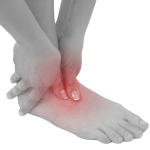Arthritis is basically the inflammation of a joint, a condition that can generate varying levels of pain and joint limitation. It frequently appears in elderly people, but also in younger adults, due to multiple causes. It is mostly evidenced in small joints and can affect the ankle, as well as other joints of the foot.
Among the different types of ankle arthritis, it is possible to find:
- Osteoarthritis: being the most frequent type, it affects elderly people, appearing after the articular surfaces of the ankle undergo degenerative changes and wear and tear.
- Rheumatoid arthritis: it is the consequence of autoimmune manifestations that can affect the joint early on, causing increased wear and tear, pain, and disability.
- Post-traumatic arthritis: appears as a consequence of injuries or fractures to the articular surfaces, which change the normal anatomy of the ankle.
The main symptom of this condition is pain, which can be located in both the ankle and the foot, appearing with movement, weight-bearing, or even at rest. It may occur in the morning or wake the person up during sleep. A typical characteristic is that the pain increases with physical activity and decreases with rest. Other signs include stiffness and functional limitation of the ankle, joint deformity, local swelling, increased temperature, crepitus on movement, among others.
To make the diagnosis, the physician will perform a physical examination of the affected joint and ask several medically relevant questions to find the origin of the condition. In addition, to confirm the diagnosis and rule out other possibilities, some more specialized tests, such as X-rays, MRI, CT scan, ultrasound of the affected area, bone scan, among others may be requested.
As for the treatment of ankle arthritis, the doctor may indicate:
- A conservative option, based on modifications of life habits, physical rest, decrease of daily physical activity, regulation of body weight, performance of physical therapy sessions, as well as the use of anti-inflammatory and pain medications.
- Or a surgical option, only when it can be performed and when the previous option is not successful, based on the removal of the affected tissue from the joint, the fusion of the articular bones, or the placement of an ankle prosthesis.


Recent Comments